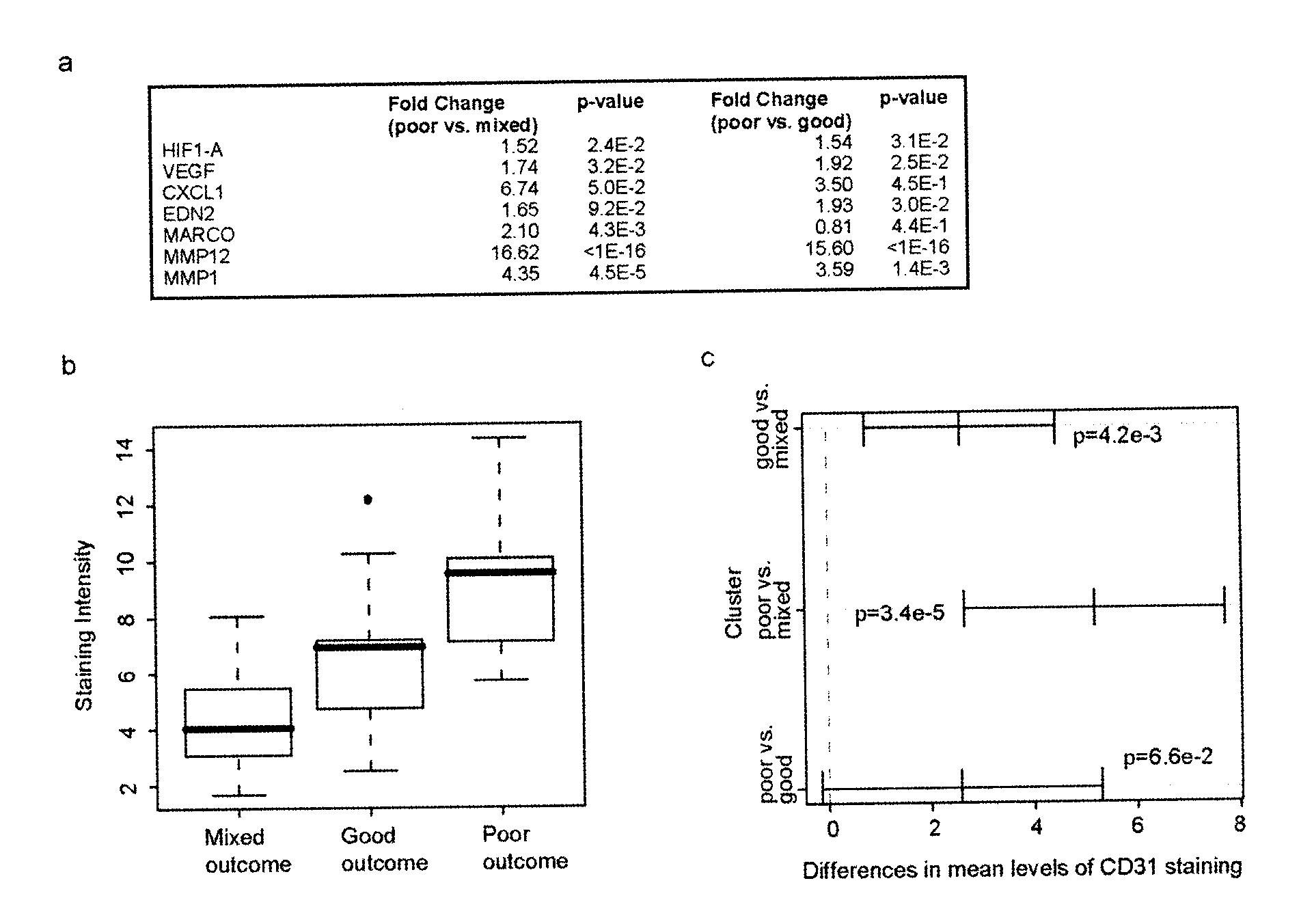Stroma Derived Predictor of Breast Cancer
a breast cancer and stroma technology, applied in the field of cancer, can solve the problems of increasing the risk of recurrence, challenging the identification of patients at increased risk of recurrence, and focusing on more aggressive systemic therapy, and achieve the effect of improving clinical outcome prediction
- Summary
- Abstract
- Description
- Claims
- Application Information
AI Technical Summary
Benefits of technology
Problems solved by technology
Method used
Image
Examples
example 1
Methods
Description of Samples
[0216]Tissue samples from 73 patients presenting with invasive ductal carcinoma (IDC) were subjected to laser capture microdissection (LCM). From this cohort, 53 samples were obtained of tumor-associated stroma; in 31 cases, patient-matched normal adjacent stroma was also obtained. The median follow-up of our patients was 3.44 years. Recurrence (local or distant) was determined by examination of medical records following diagnosis. Poor outcome was defined as alive with disease or dead of disease as of the time of the latest follow-up. No patient in the study received neoadjuvant therapy. This study was approved by the McGill University Health Centre (MUHC) Research Ethics Board (protocols SUR-00-966 and SUR-99-780), and all subjects provided written, informed consent.
LCM, RNA Isolation and Microarray Hybridization
[0217]Regions of tumor-associated and normal stroma were identified by a clinical pathologist prior to microdissection. LCM, sample isolation ...
example 2
SDPP Integration with Other Predictors
Integration of Multiple Predictors
[0249]The independent predictions of the 70-gene predictor, wound response signature, hypoxia signature, and our SDPP in the NKI data set were combined, to construct a Bayes' classifier of metastasis. The structure of the classifier was to condition metastasis on the output of wound response, 70-gene, hypoxia, and the SDPP. In order to compare the good and poor-outcome classes of each predictor, cases predicted as mixed or intermediate outcome for the SDPP and wound signatures, respectively, were removed for training. Posterior probabilities of metastasis were then estimated given different combinations of each predictor, including the case where information from a predictor was not used.
Bayesian Network Integrating the Hypoxia, 70 Gene, and Wound Signatures with the SDPP.
[0250]The structure and parameters of the Bayesian network that integrates the 70 gene, wound response, and hypoxic transcriptional response w...
example 3
Identification of Genes Differentially Expressed in Tumor Associated Stroma of Other Cancers for Predicting Outcome
Description of Samples
[0253]Tissue samples comprising tumor associated stroma and normal stroma from cancer patients such as colon cancer patients or lung cancer patients are subjected to laser capture microdissection (LCM). Recurrence (local or distant) is determined by examination of medical records following diagnosis. Poor outcome is defined as alive with disease or dead of disease as of the time of the latest follow-up.
LCM, RNA Isolation and Microarray Hybridization
[0254]Regions of tumor-associated and normal stroma are identified by a clinical pathologist prior to microdissection. LCM, sample isolation and preparations, as well as microarray hybridization, are carried out as previously described23. Normal stroma is harvested at least 2 mm away from the tumor margins. Each RNA sample is hybridized on Agilent 44K whole human genome microarrays in a dye-swap replicat...
PUM
| Property | Measurement | Unit |
|---|---|---|
| temperature | aaaaa | aaaaa |
| temperature | aaaaa | aaaaa |
| temperature | aaaaa | aaaaa |
Abstract
Description
Claims
Application Information
 Login to View More
Login to View More - R&D
- Intellectual Property
- Life Sciences
- Materials
- Tech Scout
- Unparalleled Data Quality
- Higher Quality Content
- 60% Fewer Hallucinations
Browse by: Latest US Patents, China's latest patents, Technical Efficacy Thesaurus, Application Domain, Technology Topic, Popular Technical Reports.
© 2025 PatSnap. All rights reserved.Legal|Privacy policy|Modern Slavery Act Transparency Statement|Sitemap|About US| Contact US: help@patsnap.com



